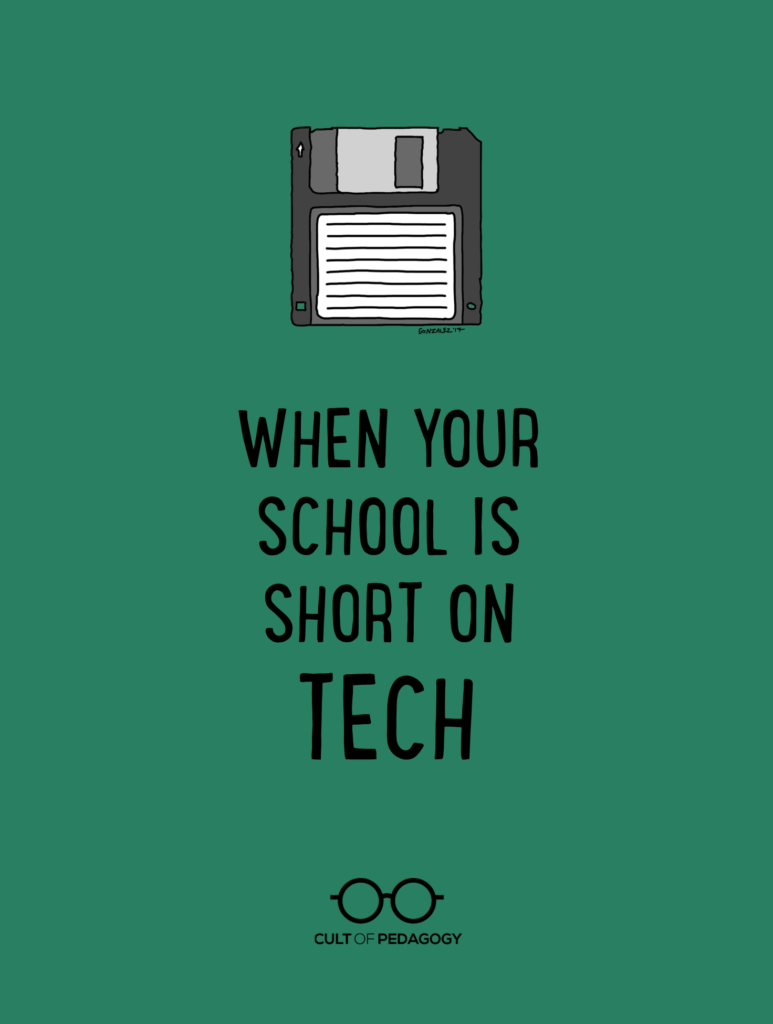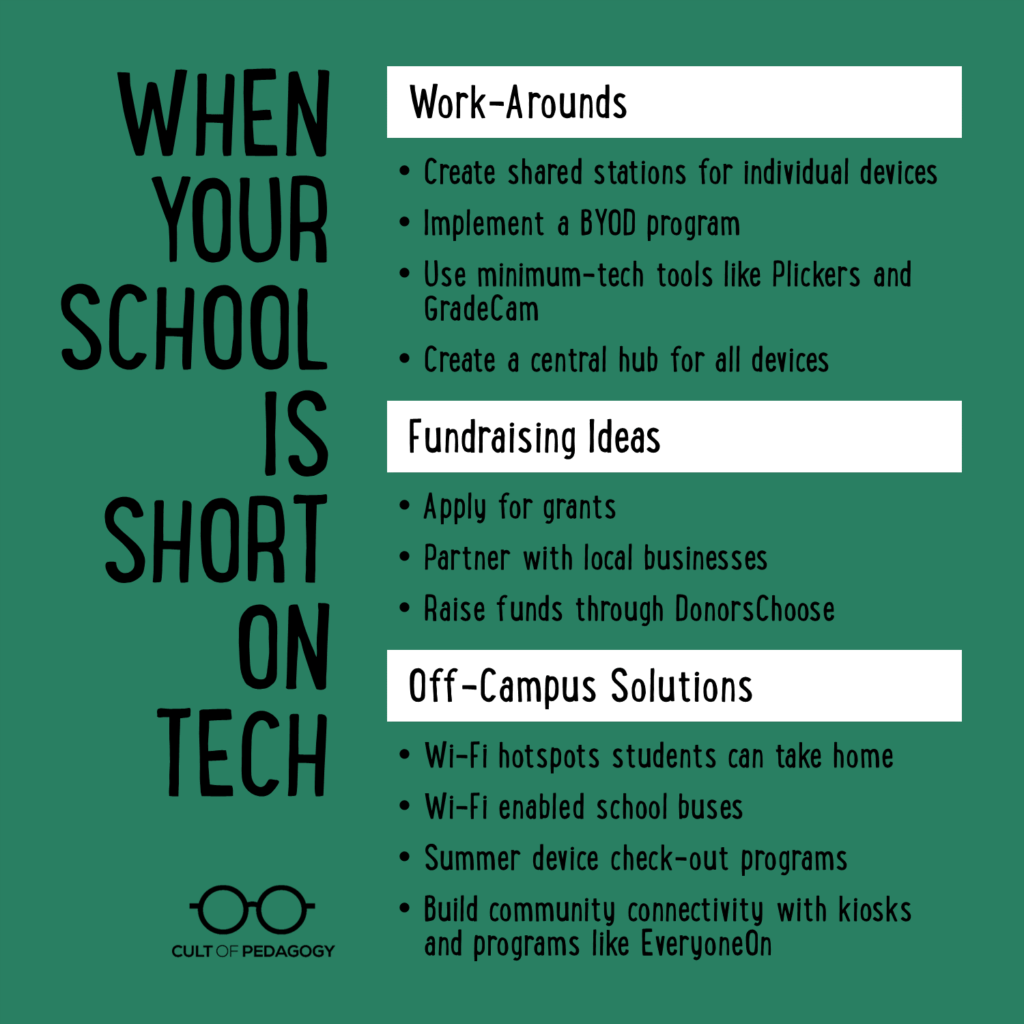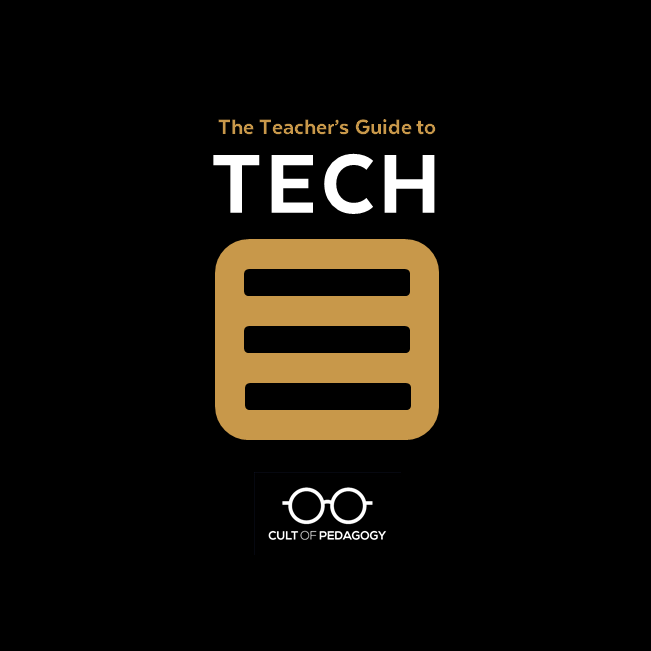
Listen to this post as a podcast:
Sponsored by Raymond Geddes and Kids Discover
So there I am, right in the middle of a presentation on HyperDocs, showing a group of teachers how they could use this online framework to build all kinds of interactive lessons, differentiate instruction, get students caught up after an absence…I was basically touting it as the Swiss Army Knife of ed tech tools. I’m all, “You can do this, and this, and even this…”
And then it happens. One teacher raises her hand and asks, “What if we only have two Chromebook carts for the whole school?”
Hear that Debbie Downer sound? Yep, that was my brain.
The teacher went on to describe her situation. Far too often, the Chromebooks at her school sat unused, because it was too much of a pain to sign them out and plan for short-term use. Teachers certainly couldn’t use anything like the hyperdocs or self-paced learning on a consistent basis, because students could only get online every now and then.
While some schools have already gone 1:1—with a device for every student—others don’t even have reliable Internet access, let alone enough devices for students to use, even if they share. This issue has a name: It’s called digital equity. Just like with books, science equipment, extracurricular options, and healthy, fresh food in the cafeteria, technology is now another resource that’s abundant in well-funded schools and lacking in underfunded schools, creating one more way low-income students will fall behind their more affluent peers.
When that teacher described her situation, I brainstormed a few possible solutions with her, but I knew better ones had to be out there. And they are: If you’re in a school where the technology is in short supply, and you believe your students are falling behind their peers because of it, you have options.
I’m going to share eleven specific solutions you can choose from to start improving students’ access to tech in your school. You can pick just one or mix up a few of them, but in this list, there’s definitely something that can start to make a real difference in giving your students more of the opportunities technology has to offer.
Two Important Questions to Consider
Before we get into the specific solutions, ask yourself these two questions:
First, Does a regular classroom teacher have the power to give students more access to technology in a whole school?
I ask this one first because I suspect this is the thing that might be holding you back, the reason you haven’t done more than shake your head at your school’s lack of tech. You’re “just a teacher.” You have no control over the school’s budget. You can’t change the tax laws in your community.
I think you have more power than you realize. Your administrators are doing the best they can with the knowledge and money they have, but technology is just one small piece of all the stuff they’re responsible for. If you and a small group of your colleagues committed yourselves to improving your school’s tech infrastructure, to identifying which changes would make the biggest impact and figuring out how to fund them without cutting into the existing budget, your administrator would be crazy to turn you down.
I think it’s definitely worth a shot. A serious, carefully planned shot.
Which brings me to my second question: Will having more technology automatically improve student learning at your school?
The answer to this one is definitely NO. Simply boosting your school’s Internet bandwidth or adding more devices will not magically improve the education you offer.
You need a better plan than that.
Start by getting very clear on the learning goals you’re hoping to achieve with more technology. What is the end goal? What will teachers and students be able to do with more tech that they can’t do now?
Here are some important things technology can do to improve learning. Consider whether your plan embraces some or all of these:
- Technology increases opportunities for students to take ownership of their learning through self-paced models, inquiry-driven projects, and authentic tasks that allow them to engage with content in ways that reflect how it is used in the real world.
- Technology allows teachers to assess student learning more efficiently and effectively in order to differentiate instruction and challenge every student appropriately.
- Technology provides students with more flexible options for learning, so they can learn at school and at home, developing habits that will allow them to become lifelong learners.
- Technology gives students tools to create original products and share them with the world. Rather than simply doing tasks “for school,” they can pursue their talents and passions and share their work in communities of real artists, writers, filmmakers, photographers, journalists, scientists, historians, designers, and engineers. (See some of these here.)
If your plan for increased technology doesn’t allow for much of this, you may want to rethink things first. These standards for educators and students, put out by the International Society for Technology in Education (ISTE), would be a good place to start when crafting a vision for your school.
So let’s explore some of the creative ways schools are addressing the digital divide. I’m putting the solutions into three groups: work-arounds, fundraising ideas, and off-campus solutions.
Work-Arounds
These are the fastest to implement: Rather than attempt to change the amount of tech your school has, these work-arounds will help you make the most of what you do have.
1. Create centers or stations where students take turns using single devices. These might be permanent centers that students can access at any time, or centers that are part of a specific station-rotation model. You might have devices set to specific sites or programs or create a physical menu of options students can use during their time at that center. Even if your classroom only has a single computer, you can get a lot out of it by setting up guidelines and routines to make sure students know how and when to use it. These resources can get you started:
- Blended Learning with Catlin Tucker: This 7-video series by McGraw-Hill Education provides an excellent overview of how to set up and run a blended learning environment in your classroom. Tucker walks the viewer through specific stations so you can get an up-close look at what students are actually doing at each one, along with how tech is integrated into some of them, which will help you imagine how you might do the same in your classroom.
- Spruce up Your Centers with Technology: This blog post and video by Tony Vincent focuses on the specific things you can do to set up technology-driven centers, including which programs and tools you can use to create videos, provide instructions for stations, and give students opportunities to be creative.
2. Implement a Bring Your Own Device (BYOD) program that allows students to bring devices from home for use in school. This can quickly increase the number of devices in your school without the need for any increased funding. If you choose this route, do it carefully: Without a clear plan in place, a BYOD program can cause lots of problems. Two resources that can help are listed below. They include advice on getting buy-in from parents, creating an acceptable use policy, and making sure your school network can handle increased use by more devices.
- 9 Best Practices for Getting Started with BYOD published by Edmentum
- BYOD Guidebook published by ClassLink
3. Use Minimum-Tech Tools that only require the teacher to have a device:
- Plickers allows teachers to scan responses that students hold up on paper sheets; only one device required.
- GradeCam lets teachers create paper answer sheets that can be scanned with a single device.
4. Create a Tech Hub at your school where most devices are kept in one central location. Students then go to the hub to use the devices, which ensures they are put to maximum use and rarely ever sit idle.
- Check out our story about the Learning Center at Big Walnut Middle School. What was once an underutilized library turned into an essential, active part of the school once tech resources were centralized and a system was created for teachers to send students there to work on specific tasks.

Fundraising Ideas
It might be that you just need to raise more cash to pay for the technology. Here are some ways to get that done.
5. Raise funds through crowdfunding sites like DonorsChoose. With this approach, teachers often target specific hardware that they’d like for their classroom, such as a collection of Chromebooks. See more examples of successfully funded projects here.
6. Partner with local businesses and organizations to raise funds and provide better access.
- This Cincinnati high school partnered with the local phone company to get devices and tutoring for students.
7. Apply for grants: This is one of the more difficult ways to go about raising funds, but if you learn how to do it, it can be a great source of funding.
- This guide from Education World offers good advice for successful grant writing.
- eSchool News maintains a list of grants you can keep an eye on.
- also see this list put together by Dreambox Learning.
Off-Campus Solutions
When technology is limited at school, it is often limited at home as well, which can put students at a further disadvantage. When addressing digital inequities in your school, think beyond the boundaries of your campus.
8. Portable Wi-Fi hotspots can be checked out by students, giving them Internet access in homes that otherwise wouldn’t have any. Kajeet offers the SmartSpot, which can be filtered so that students can only access educational content. This Wisconsin high school uses Kajeet with students, and this public library in Prince George’s County, MD, checks them out to the public.
9. Wi-Fi enabled school buses, also offered by Kajeet, allow students to get work done on the ride to and from school. This California district installed these systems on its buses, and has many of them park right in students’ neighborhoods, so they can get access at home.
10. Summer device check-out programs allow students without devices to check out school-owned devices and continue their access over the summer months. Read about how this Kansas school district did it.
11. Build community connectivity. Districts can work toward setting up Wi-Fi kiosks in local neighborhoods. Organizations like EveryoneOn work to get low-cost Internet, refurbished devices, and computer literacy training to unconnected families. If you pull resources from everywhere in your community, like this North Carolina town did, you’ll not only build greater capacity for student learning; you’ll create more opportunity for everyone. ♦
Want to make smart tech choices for your classroom?
The Teacher’s Guide to Tech is a user-friendly encyclopedia of tech tools, organized by category. Thousands of teachers have used it to quickly find just the right tools for their students. If you’re feeling overwhelmed by all the choices out there, this guide will be a game-changer for you.

Learn more here.
Join my mailing list and get weekly tips, tools, and inspiration—in quick, bite-sized packages—all geared toward making your teaching more effective and fun. You’ll get access to our members-only library of free downloads, including 20 Ways to Cut Your Grading Time in Half, the e-booklet that has helped thousands of teachers save time on grading. Come on in!!





I always enjoy your posts, and this was timely. You mentioned that lower income/achieving schools don’t have tech, but I work at a high-achieving school in an upper-middle class neighborhood and we are a tech desert — one chrome cart for each 175 students. Maybe the administrators don’t see it as a pressing need since we achieve without it. This is an issue for all kinds of schools. We’re hopeful to get one more cart for each 175 person team this year. Fingers crossed!
Becky is your school still a tech desert? can you give a hint to what school you are referring too?
Thanks
Thank you for this blog post! I went from a school with 1:1 but recently moved to a Title I school with desktop only sets. I appreciate the time you took to highlight that, yes, there is an inequity in tech for schools and steps we can take to rectify them.
I love to learn from you posts, am crushed for time so glanced quickly at this one. Look into Raspberry Pi3 as an alternative, inexpensive computer tool. It runs on LINUX and is quite inexpensive – it may be an interesting alternative to expensive computer labs. Students can also learn programming on it. I am hoping to have my students build their own ones this year. Fingers crossed. Any way, it may answer a few needs as it was created for schools that couldn’t afford computers.
First, I have to request that my reply is anonymous. I just left a school that not only severely penalized teachers for using a cell phone during the day, they did not allow teachers to bring in their own devices to use in the classroom. I heard from a fellow elementary teacher who would smuggle in an iPad to use with the class. She elicited conspiracy with her young charges, so that admin would not find out. Please know that there are teachers out there that are hamstrung by unrealistic district rules. I’m so glad I left!
These suggestions are all great. But, what if the problem is not that the entire school is low on tech, just that your particular subject (ART) is not considered important enough to have any tech. I know what tech in my art classroom would do to improve my students’ learning, but admin does not think it is a worthwhile expense. I’ve given examples of why I would like to have at least a computer and overhead projector, and still nothing. I literally have zero tech. Not a computer, tablet, overhead project, nada. I have to print out letter size art images on my home computer and color printer to bring in to show students. Its kinda sad. I can’t afford to purchase my own tech for school use and I can not do the crowd funding or grants that I’ve researched because I’m not at a public school (Catholic school). We have no school board, no PTA. So, how to do I get financial support for tech in the art room? Any suggestions?
While these suggestions are all good what do you do when it’s the actual internet connection that’s the problem? The school I was at last year was 1:1 with an iPad for every student however because of where the school was located satellite internet was the only option. This meant that no more than 5 devices could use the internet at one time and there were many days when nobody could get on. The weather was a major influence on whether or not we had an internet connection. There was no cell phone service in the area so we couldn’t use that either. Thankfully there are many apps that do not require internet access once they are downloaded but downloading apps was another headache as one download could sometimes take a day or more to complete.
I have always found, that when students area allowed to chip in, for the purchase of their own I-Pads, then they really want to learn.
Recycling might be an idea, which the local news might want to also get behind in order to generate some sponsors who can give the entire technology program a bit more monetary traction, and with today’s crowdsourcing, educators have even a greater resource for funding. I have also found, that when asking each student to at least chip in six aluminum cans or six plastic bottles per day they can generate money enough to eventually buy say http://mathletics.com for the entire class to greatly improve their mathematics training.
Buying older models of laptops, in bulk, so that students can sell some, and then to keep a portion for school use and for them to take home, might also be something which to consider.
We have 25 chrome books for over 350 students. Which is not surprising, since fourth and fifth grade don’t even have textbooks because we can’t afford them…but somehow, we are supposed to give them STAR tests every six weeks (every student) and they are supposed to make AR goals every six weeks…there’s a head scratcher. I tried donors choose but couldn’t get donors…
Thank you for the great post! So many creative ideas that can be implemented right away. Currently, our school has about 5 laptops (Lenovo thinkpads) per class, but want to go 1:1. I’ve been pushing the use of google classroom and all of the extensions and apps connected to it (can I get an AMEN for hyperdocs?!). Given this information, would Chromebooks be the best route to go in terms of purchasing devices for students, or are there other, better alternatives?
Thank you!
Hi, Julia! I work as a Customer Experience Manager for Cult of Pedagogy. Your question has been run by Jenn, and her opinion is to go with Chromebooks. You mention pushing Google Classroom and Chromebooks are made for that. They’re also a relatively “cheap” option (although that word has a different meaning for everyone).
Check out Matt Miller’s post (Ditch that Textbook) about why he chooses Chromebooks for 1:1.
While Jenn considers Chromebooks as a safe bet, we still encourage you to ask around! Hope this helps.
I agree 100% with everything you said Jennifer! I work for a company specializing in virtual reality headsets and we have among our clients many school.
When we explain to teachers the many opportunities virtual reality has to offer in terms of education, everybody is very interested.
However, it is really hard to get the teachers to go and try to convince the administration of their school to invest in technology. Most of the time they rather give us the contacts information for us to call and explain what VR headsets can bring to a classroom.
The problem is that, according to the data we have collected over the past 2 years, when teachers try to get the funds: they are much more effective than corporations…
I think having such technology can lessen the time of work for teachers. It could ease their daily teaching approach and children will surely enjoy this type of method.
If your students needs to access their G Suite for Education account, the Family Link option will not work. Instead, you can add their faculty account to the Chromebook and watch them like a hawk.
Shouldn’t advocacy in your school district’s school board be a solution? I find it troubling when we always view a partnership with a private company as a solution to tech and infrastructure issues. More often a school surrounded by highly profitable coportations will see large benefits of private partnerships and the schools that are struggling most of all will have scraps in comparison. Where’s the mention of referendums as a solution?
Thank you for your suggestion of referendums as a possible solution for school districts lacking in tech resources. Jenn describes several work-around solutions to digital inequity in the post, some of which include grant-writing and pooling existing resources, such as in the section, “Implement a Bring Your Own Device (BYOD) program” that don’t require partnerships with private companies. Of course, educators can advocate in many ways for better resources for students, but the big takeaway from the post (at least how I read it) is that there is more than one option.